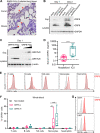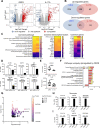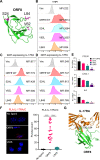Viral Mimicry of Interleukin-17A by SARS-CoV-2 ORF8
- PMID: 35343786
- PMCID: PMC9040823
- DOI: 10.1128/mbio.00402-22
Viral Mimicry of Interleukin-17A by SARS-CoV-2 ORF8
Abstract
Severe acute respiratory syndrome coronavirus 2 (SARS-CoV-2) infection triggers cytokine-mediated inflammation, leading to a myriad of clinical presentations in COVID-19. The SARS-CoV-2 open reading frame 8 (ORF8) is a secreted and rapidly evolving glycoprotein. Patients infected with SARS-CoV-2 variants with ORF8 deleted are associated with mild disease outcomes, but the molecular mechanism behind this is unknown. Here, we report that SARS-CoV-2 ORF8 is a viral cytokine that is similar to but distinct from interleukin 17A (IL-17A) as it induces stronger and broader human IL-17 receptor (hIL-17R) signaling than IL-17A. ORF8 primarily targeted blood monocytes and induced the heterodimerization of hIL-17RA and hIL-17RC, triggering a robust inflammatory response. Transcriptome analysis revealed that besides its activation of the hIL-17R pathway, ORF8 upregulated gene expression for fibrosis signaling and coagulation dysregulation. A naturally occurring ORF8 L84S variant that was highly associated with mild COVID-19 showed reduced hIL-17RA binding and attenuated inflammatory responses. This study reveals how SARS-CoV-2 ORF8 by a viral mimicry of the IL-17 cytokine contributes to COVID-19 severe inflammation. IMPORTANCE Patients infected with SARS-CoV-2 variants lacking open reading frame 8 (ORF8) have been associated with milder infection and disease outcome, but the molecular mechanism behind how this viral accessory protein mediates disease pathogenesis is not yet known. In our study, we revealed that secreted ORF8 protein mimics host IL-17 to activate IL-17 receptors A and C (IL-17RA/C) and induces a significantly stronger inflammatory response than host IL-17A, providing molecular insights into the role of ORF8 in COVID-19 pathogenesis and serving as a potential therapeutic target.
Keywords: COVID-19; inflammation; viral IL-17.
Conflict of interest statement
The authors declare no conflict of interest.
Figures






References
-
- Cascella M, Rajnik M, Aleem A, Dulebohn S, Di Napoli R. 2021. Features, evaluation, and treatment of coronavirus (COVID-19). StatPearls https://www.statpearls.com/articlelibrary/viewarticle/52171/. - PubMed
-
- Wu F, Zhao S, Yu B, Chen Y-M, Wang W, Song Z-G, Hu Y, Tao Z-W, Tian J-H, Pei Y-Y, Yuan M-L, Zhang Y-L, Dai F-H, Liu Y, Wang Q-M, Zheng J-J, Xu L, Holmes EC, Zhang Y-Z. 2020. A new coronavirus associated with human respiratory disease in China. Nature 579:265–269. doi: 10.1038/s41586-020-2008-3. - DOI - PMC - PubMed
-
- Zhou P, Yang X-L, Wang X-G, Hu B, Zhang L, Zhang W, Si H-R, Zhu Y, Li B, Huang C-L, Chen H-D, Chen J, Luo Y, Guo H, Jiang R-D, Liu M-Q, Chen Y, Shen X-R, Wang X, Zheng X-S, Zhao K, Chen Q-J, Deng F, Liu L-L, Yan B, Zhan F-X, Wang Y-Y, Xiao G-F, Shi Z-L. 2020. A pneumonia outbreak associated with a new coronavirus of probable bat origin. nature 579:270–273. doi: 10.1038/s41586-020-2012-7. - DOI - PMC - PubMed
-
- Rouvier E, Luciani M, Mattei M, Denizot F, Golstein P. 1993. CTLA-8, cloned from an activated T cell, bearing AU-rich messenger RNA instability sequences, and homologous to a herpesvirus saimiri gene. J Immunol 150:5445–5456. - PubMed
MeSH terms
Substances
Supplementary concepts
Grants and funding
LinkOut - more resources
Full Text Sources
Medical
Molecular Biology Databases
Research Materials
Miscellaneous

